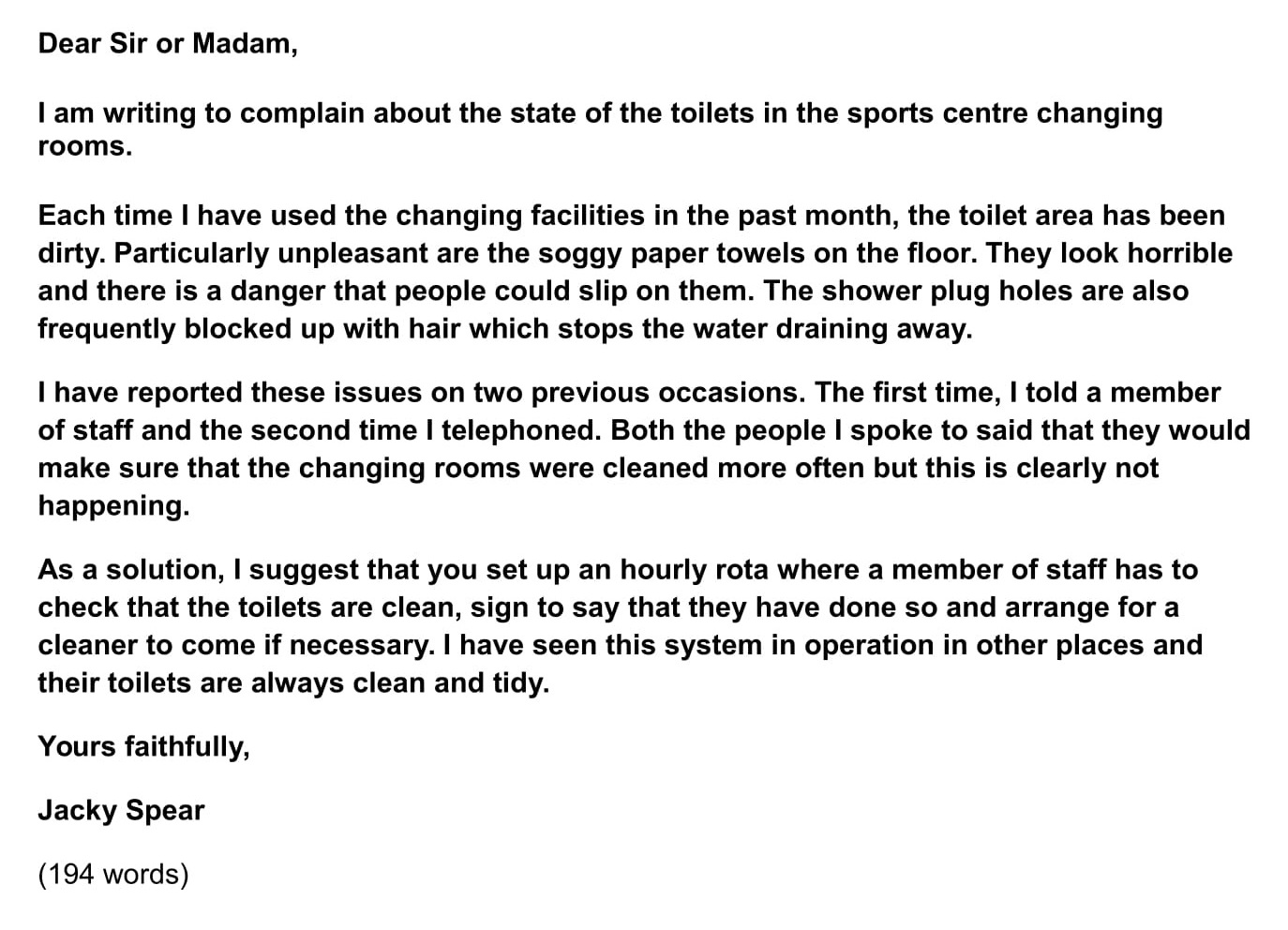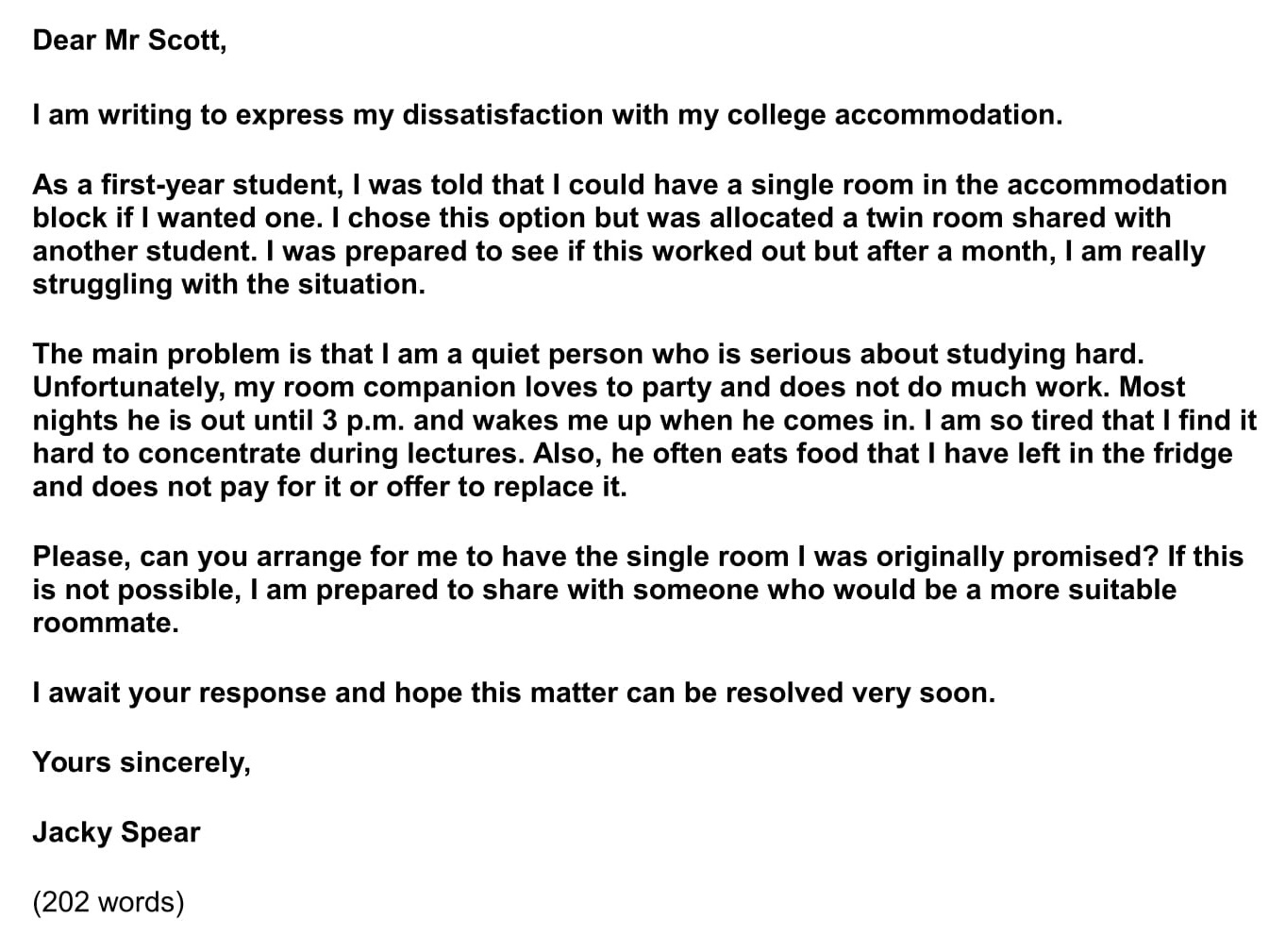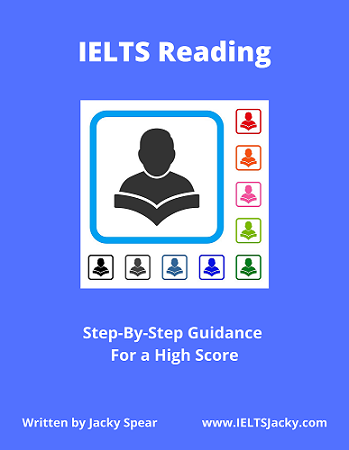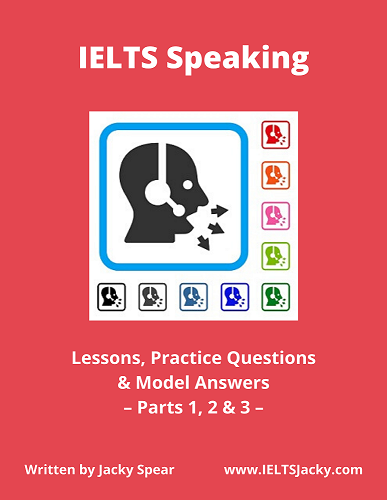IELTS Complaint Letter
In
this lesson, I show you step-by-step how to write an IELTS complaint letter.
These come up regularly in General Writing Task 1 so you need to know how to
plan and write them.
Here’s what the lesson includes:
- Question structure
- Letter structure
- Formal or informal?
- Greeting & signoff
- Generating ideas
- Sample
letters
Question structure
All questions for IELTS letters have the same structure. They are made up of 3 parts.
Part 1 – The topic.
Part 2 – The person you must write to.
Part 3 – What you should write about (listed as 3 bullet points).
Here is a sample question for a letter of complaint with the 3 parts illustrated.
|
There is a problem
with the changing rooms in the sports centre that you visit. You have
complained several times but with no success. Write a letter to the manager of the sports centre. In your letter:
|
The topic
Who you should write to What you should write about |
Understanding this will help you to quickly analyse the question and plan your answer. To help you plan, use the letter structure below.
For a full lesson on planning click here: How To Plan IELTS Letters
Letter structure
The layout of your IELTS complaint letter should follow the structure of the question and consist of four paragraphs with a greeting at the beginning and a signoff at the end.
Use this easy to remember 6 part structure.
1) Dear .....
2) Paragraph 1: Purpose – why you are writing
3) Paragraph 2: Write about 1st bullet point
4) Paragraph 3: Write about 2nd bullet point
5) Paragraph 4: Write about 3rd bullet point
6) Signoff
All you need to do to create your plan is to add in the details from the question, like this:
1) Dear ..... (manager)
2) Paragraph 1: Purpose – to complain about the sports centre changing rooms
3) Paragraph 2: describe the problem with the changing rooms (bullet point 1)
4) Paragraph 3: what happened the last times you complained (bullet point 2)
5) Paragraph 4: explain what you want the manager to do (bullet point 3)
6) Signoff
Formal & Informal IELTS Letters
Your letter must be written in the appropriate tone and style. There are two options:
- Formal – to someone you don’t know or don’t know well.
- Informal – to a friend or close family member.
It is essential that you are able to identify what type of question you’re required to write.
Follow this general rule:
- If the question includes the word ‘friend’, use informal language.
- If the question does not include the word ‘friend’, use formal language.
An
IELTS complaint letter will almost always be addressed to someone you don’t
know and will thus be a formal letter, so this is what we’ll focus on for the
rest of the lesson.
Two parts of the letter that require very specific formal language are the greeting at the beginning and the signoff at the end so we’ll begin with these.
The Greeting & Signoff
The Greeting
There are two ways you can begin your formal IELTS
complaint letter.
- Use Dear Sir or Madam if you don’t know the name of the person you are writing to.
- Use Dear + surname if you do know their name,
e.g. Dear Mr Smith or Dear Mrs Jones.
It’s very likely
that you would not know the name of someone you were making a complaint to but
if you want to use a surname, just make one up.
The greeting you use will determine how you sign off your letter.
The Signoff
For a formal letter, there are two main options. The correct one will depend on who you are addressing:
- Dear Mrs Jones (name known) – Yours sincerely
- Dear Sir/Madam (name unknown) – Yours faithfully
Always sign off a formal letter with your full name, e.g. Jacky Spear
For our sample letter, we will use this greeting and signoff:
Dear Sir or Madam...
...Yours faithfully,
Jacky Spear
We are now ready to think up some ideas to write about. We have the guidelines of the 3 bullet points to help us so this won’t be difficult.
How To Generate Ideas for an IELTS Complaint Letter
You are only required to write 150 words, so you won’t need many ideas. Just make sure that you write about each bullet point and develop each idea fully.
The ideas don't have to be the best ones you can think of. Go with your first thoughts and don’t waste time trying to think up better ideas. However, it’s essential that the ideas are directly related to the bullet points.
Note them beside each bullet point on the exam paper, like this:
There is a problem with the changing rooms in the sports centre that you visit. You have complained several times but with no success.
Write a letter to the manager of the sports centre. In your letter:
- describe the problem with the changing rooms
The toilets are dirty
- what happened the last times you complained
Promised the problem would be addressed.
- explain what you want the manager to do
Rota list for staff to check every hour and sign.
That’s
our planning complete. Once you’ve had some practice, you’ll be able to do this
in just a few minutes. Taking time to plan will make writing your IELTS complaint
letter far quicker and easier than if you don’t do this step. You will also
write a better letter and get higher marks.
Next, we’re going to write our letter.
Writing the Letter
Here’s our plan again with all our notes added in.
1) Dear ..... (manager)
2) Paragraph 1: Purpose – to complain about the sports centre changing rooms
3) Paragraph 2: describe the problem with the changing rooms (bullet point 1)
The toilets are dirty
4) Paragraph 3: what happened the last times you complained (bullet point 2)
Promised the problem would be addressed.
5) Paragraph 4: explain what you want the manager to do (bullet point 3)
Rota list for staff to check every hour and sign.
6) Signoff
We’ve already decided on the greeting so we’ll start with paragraph 1.
Paragraph 1
In the first paragraph, you must state the reason for writing the letter, that is, its purpose.
Paragraph 1: Purpose – to complain about the sports centre changing rooms
Many students make the mistake of missing this purpose sentence out but it's very important. Including it will gain you marks.
It only requires one sentence. Here are 4 different phrases you could use to start an IELTS complaint letter.
- I am very unhappy with / about….
- I am writing to complain about….
- I am extremely dissatisfied with / about
- I write to express my disappointment…
This is how we will start our letter:
I am writing to complain about the state of the toilets in the sports centre changing rooms.
Top vocabulary tip: Do not use contractions in formal letters. They are informal language. So, do not write ‘I’m writing to complain…
Paragraph 2
In the second paragraph, you write about bullet point 1.
Paragraph 2: describe the problem with the changing rooms (bullet point 1)
The toilets are dirty
Remember to keep the language formal for this question. Aim for around 50 words for each of paragraphs 2, 3 and 4. You could write something like this.
Each
time I have used the changing facilities in the past month, the toilet area has
been dirty. Particularly unpleasant are the soggy paper towels on the floor.
They look horrible and there is a danger that people could slip on them. The
shower plug holes are also frequently blocked up with hair which stops the
water draining away.
Paragraph 3
The third paragraph should cover the second bullet point.
Paragraph 3: what happened the last times you complained (bullet point 2)
Promised the problem would be addressed.
For example,
I have reported this issue on two
previous occasions. The first time, I told a member of staff and the second
time I telephoned. Both the people I spoke to said that they would make sure
that the changing rooms were cleaned more often but this is clearly not
happening.
Paragraph 4
Paragraph 4 addresses the third bullet point.
Paragraph 4: explain what you want the manager to do (bullet point 3)
Rota list for staff to check every hour and sign.
As
a solution, I suggest that you set up an hourly rota where a member of
staff has to check that the toilets are clean, sign to say that they have done
so and arrange for a cleaner to come if necessary. I have seen this system in operation
in other places and their toilets are always clean.
Now we just need to add the signoff we decided on earlier and our letter is complete.
The Finished Letter
Here's our finished IELTS complaint letter.

Practice Question
To get some practice writing an
IELTS complaint letter, write a letter for the question below. Use the planning
structure I showed you above to plan before you start writing.
You live in a room in college which you share with another student. There are many problems with this arrangement and you find it difficult to work.
Write a letter to the accommodation officer at the college. In the letter:
- describe the situation
- explain the problems and why is it
difficult to work
- say how you would like the
situation resolved
Here’s
a sample letter.

You'll find lessons on other common IELTS letter topics in the menu below.
|
Listen to this lesson on How To Write an IELTS Complaint Letter? Click on the video. |
Like this page?
Common Letter Topics
IELTS Letters – All Lessons
IELTS General Writing – A summary of the test including important facts, test format & assessment.
Letter
Format – The format, the 7 topics, letter
structure, formal & informal, assessment & marking criteria, sample
questions. Essential information you need to know.
Letter Writing Tips – Learn top tips on how to meet the assessment and marking criteria and achieve a high score.
Letter Writing Structure – Find out how to use this easy to learn letter structure to write a high-scoring letter. Includes a model answer.
How To Plan a Letter – Learn a simple 5 step process & 6 part letter structure. Also, help to understand the question & generate ideas.
Formal or Informal – How to decide what type of
letter to write. Sample questions & 2 model letters.
Letter Writing Vocabulary – Learn useful phrases to help you achieve a high score. Also, know how to start & end your letter.
How To Write an Informal Letter – Step-by-step instructions, simple 4 step plan & 6 part letter structure, model letter.
How To Write a Formal Letter – Step-by-step instructions, simple 4 step plan & 6 part letter structure, model letter.
Letter Topics – Learn the 7 most common letter topics & other popular subjects. Includes 20 sample questions.







